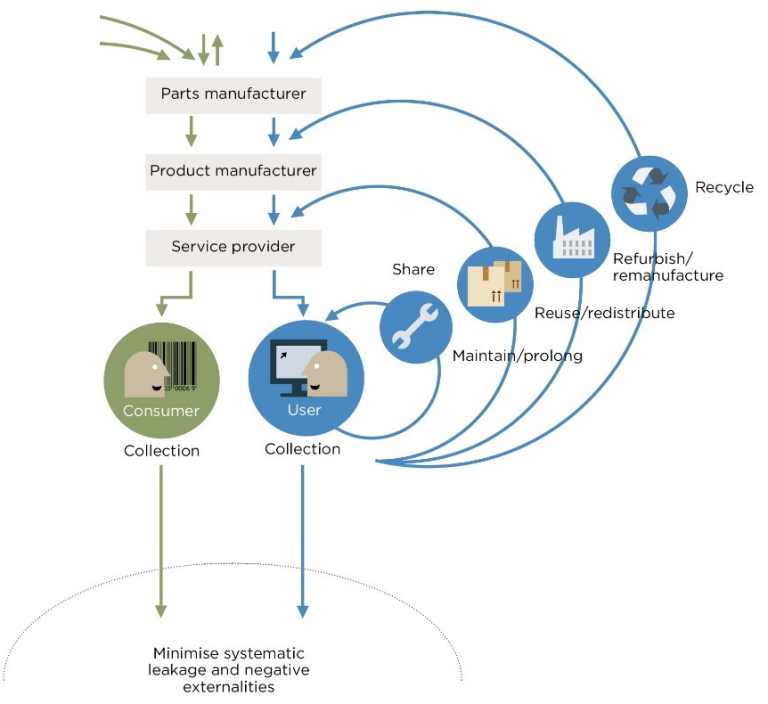The Circular Economy aims to improve environmental sustainability through processes and products redesign, reuse and recycling at the end of the life cycle, minimizing the consumption of new raw materials and energy. The following picture is part of a diagram available on the Ellen McArthur Foundation website https://www.ellenmacarthurfoundation.org that has long been on the forefront of this topic.

The role of Retail
The role of Production is fundamental in moving to more sustainable products and processes, but the role of Retail is not less important, as for example in the collection of used products for sharing immediately or after maintenance and sale of products refurbished / remanufactured upstream, reducing the waste of raw materials and the depletion of landfills.
The rent or purchase of used products leads directly to a lower environmental impact even for those not specifically designed for sustainability. The higher the use during the whole lifecycle, the lower the number of specimens produced and finally sent to landfill.
If the re-use and recycling of products recall the post-war period or the ancient farmer culture, we should note that the growing environmental sensitivity is leading to a return of attitudes that seemed vanished forever. Recently some Hollywood celebrities and some part of the Californian or New York society consider “cool” to repair shoes, handbags and clothes, contributing to the revival of artisans. The doggy-bags to bring home the leftovers of a restaurant lunch are spreading.
The examples of international Retailers active in this field are already quite long, with rapidly evolving formats and ideas. An example is Le Tote https://letote.com/ which rents clothing sets coordinated and consistent with the customer’s style and renews them periodically. If the customer like particularly a garment she can buy and retain it. Obviously, at each change the clothes are refurbished and sanitized.
A suggestion to Retailers is to tackle these changes with curiosity and creativity, looking at emerging lifestyles without being too influenced by mainstream.
How can Information Technology contribute?
With the Internet, the Cloud and now also Artificial Intelligence, the software is undergoing a profound transformation that, not surprisingly, supports the Circular Economy ideas in different ways. Regarding Retail stores, the following needs can be mentioned:
-
Purchase must become an increasingly informed choice, so the Software must make available a catalogue with the characteristics of each product on sale and direct access to the manufacturer’s information. This catalogue must be available at Point of Sale, Mobile Apps for employee and customers, traditional Kiosks and new ones based on Chat Bot (systems that support intelligent conversations with customers), and many others, including those not yet invented.
-
The Software must be easily reusable and data shared inside and even outside the chain. This requires an accurate decomposition of software in building blocks designed for cooperation, also called services, avoiding uneconomical and harmful duplications.
-
The Software must be agile and open, capable of adapting to market changes and able to collaborate with other services, including from other manufacturers and built on different technologies. Those paradigms unknown in IT a few decades ago are the foundation of modern Cloud-native software services (SaaS). The easy integration with other software services means Lego-like building of new scenarios. For example, Click and Collect (ordering on the Internet and picking up in stores) requires close and real-time integration between online and offline, even at night when stores are closed.
-
The Software must be efficient both from the point of view of hardware requirements and energy consumption. With services designed from the ground up to exploit the full potential of modern Cloud platforms, technical complexity is eliminated from stores and moved to the Cloud. PCs used in the stores can be inexpensive and use less energy. Moreover, at night they can be switched off, with additional advantages on safety. In contrast, many traditional systems use relatively powerful and expensive servers at each store, turned on 24 hours a day in order to exchange data with HQ. The balance between the resources used in the Cloud and those saved in stores is remarkably positive. In fact resource sharing and rapid elasticity are among the essential paradigms introduced by the Cloud. This means that machines are used at maximum capacity and their count increase or decrease according to the workload, eliminating any waste.
-
The Software must increase the efficiency of the entire supply chain by contributing to get the right products in each store, without waste and without excessive risks of not being able to fulfil all requests. The unsold products, when not directly wasted, are heavily discounted and purchased more for the opportunity than for the actual usefulness, encouraging waste anyway. Advanced forecasting algorithms at single-item and single-store are essential to achieve these results.
aKite, the first Cloud-native SaaS on the market, applies all these guidelines. It is therefore an example of architecture and functionality synergic to Circular Economy while these sensibilities are very rare in the traditional software still in use in most stores.
Archivio
35010 Vigonza (PD)
P.IVA/C.F: 02110950264
REA 458897 Cap.soc. 50.000€
Software
Blog
© Copyright 2023 aKite srl – Privacy policy | Cookie policy